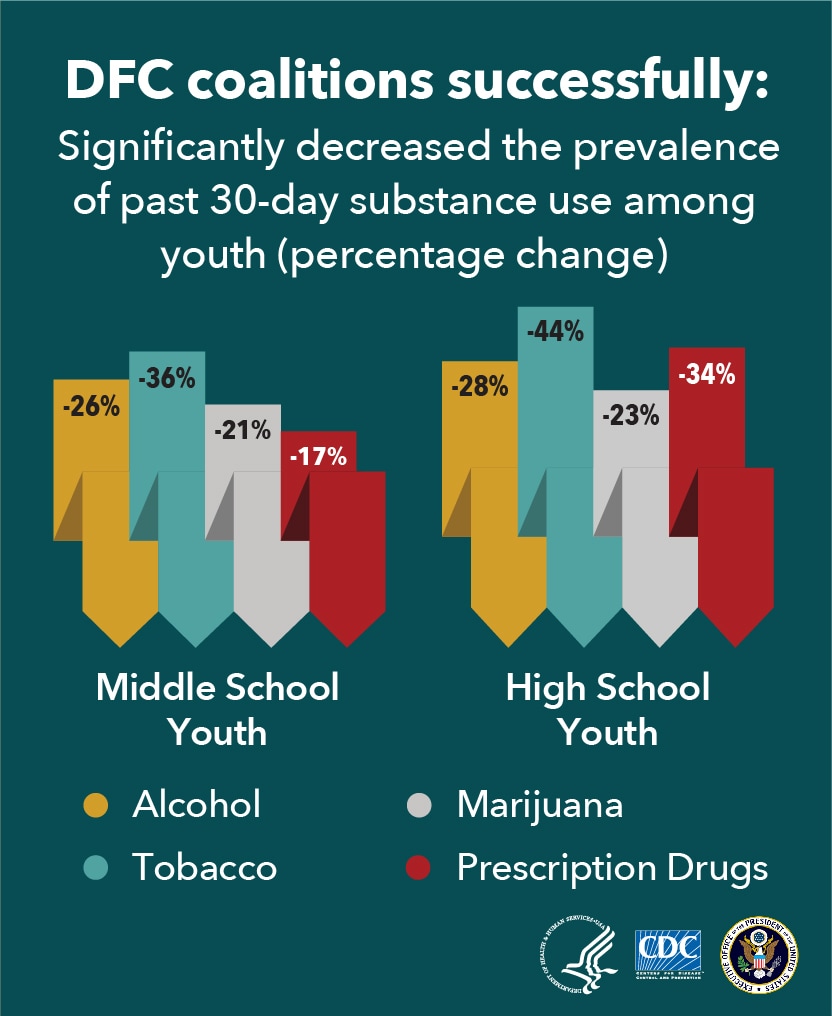Communities Are Leading the Way to Prevent Youth Substance Use
The Drug-Free Communities Program is the nation’s leading effort to support communities working to prevent youth substance use.

This year marks the 25th anniversary of the Drug-Free Communities Support Program (DFC). Since its inception, the DFC program has been a central component of our nation’s youth substance use prevention strategy. The program has grown from $10 million in 1998 to over $110 million in 2023, a testament to its bipartisan support.
Led by the Office of National Drug Control Policy (ONDCP) in collaboration with the Centers for Disease Control and Prevention (CDC), the DFC program provides funding and support to community coalitions to prevent and reduce youth substance use. The DFC program goals are to:
- Establish and strengthen collaboration among communities, public and private non-profit agencies, and Federal, state, local, and tribal governments to support community coalitions working to prevent and reduce youth substance use.
- Reduce substance use among youth and, over time, reduce substance use among adults by addressing the factors in a community that increase risk for substance use and promoting factors that minimize risk for substance use.
While youth substance use has declined over time, recent data from CDC’s Youth Risk Behavior Survey (YRBS) show that progress has slowed down in reducing adolescent’s use of electronic vaping products and misuse of prescription opioids. In 2021, 23% of high school students consumed alcohol, with almost 11% of high school students engaging in binge drinking. Tobacco use remains common, with about 19 of every 100 high school students (18.7%) reporting current use of a tobacco product, mainly driven by electronic vapor products. Approximately 16% reported current marijuana use and 6% reported current prescription opioid misuse.1
Disparities in substance use persist and across almost all measures of substance use, female students are faring more poorly than male students.
- White students were more likely than Asian and Black students to have ever used select illicit drugs
- Black and Hispanic students were more likely than Asian and White students to currently misuse prescription opioids
- Black students were less likely than almost all other students to currently use alcohol, but more likely than Asian, Hispanic, or White students to currently use marijuana
- Students who identify as lesbian, gay, bisexual, questioning, or another non-heterosexual identity (LGBQ+) and those who have any same-sex partners were more likely than their peers to have used or misused substances (i.e., ever used select illicit drugs, ever or current prescription opioid misuse, and current alcohol, marijuana, and electronic vapor product use)1
DFC coalitions are uniquely situated to leverage historical knowledge and the unique needs and assets in their communities to address youth substance use by requiring comprehensive prevention planning with an emphasis on community level change.
The DFC Program provides funding to over 700 coalitions nationwide. Coalitions are eligible to receive up to 10 years of funding to promote positive youth engagement and address the local conditions that drive youth substance use. Coalition leaders work together with representatives from 12 sectors to ensure that a broad range of community expertise is included. The 12 sectors are youth, parents, business, media, school, youth-serving organizations, law enforcement, religious or fraternal organizations, civic or volunteer groups, healthcare professionals, state or local agencies, and other local organizations. Working together, DFC coalitions empower local leaders to build communities that foster a safe environment for young folks to learn, grow, and thrive. your Community by Getting Involved with a Drug-Free Community Coalition near you.
Coalition work is guided by evidence-based frameworks such as the Seven Strategies for Community Change developed by CADCA and the Strategic Prevention Framework developed by the Substance Abuse and Mental Health Services Administration (SAMHSA) and includes activities like:
- Changing community-wide policies
- Changing school policies
- Designing communication campaigns
- Hosting drug-free social events
- Empowering youth to engage in community change
- Offering youth and parent education and training
These policies and activities can help address risk factors for youth substance use, such as the availability of alcohol and drugs, and promote protective factors, such as strong relationships with trusted adults.2,3

Youth engagement is critical to youth substance use prevention. In 2022, over two-thirds (67%) of coalitions reported hosting a youth coalition, and these same coalitions reported significantly higher levels of youth, law enforcement, parent, and school sector involvement. Nearly 20% of coalitions reported that schools were the lead sector, serving a crucial role in connecting the coalition to youth and families and vice versa.4
Evaluation findings reported annually indicate that the DFC program is making a difference in local communities. In 2022, DFC coalitions reported that substance use declined among young people living in their communities and that they significantly increased the number of young people who choose not to use substances.4
Learn more about how coalitions are working to reduce and prevent youth substance use in their local communities: Drug-Free Communities Program Successes.
For more information about the DFC Program National Evaluation, visit ONDCP. To see if there is a DFC coalition near you, see Drug-Free Communities Coalitions.
If you are involved in a community coalition and are interested in applying, visit the Funding Announcements page for upcoming opportunities.
- Centers for Disease Control and Prevention Morbidity and Mortality Weekly Report. Youth Risk Behavior Surveillance United States — 2019. https://www.cdc.gov/healthyyouth/data/yrbs/pdf/2019/su6901-H.pdf. Accessed September 26, 2022.
- Centers for Disease Control and Prevention. Adolescent Behaviors and Experiences Survey — United States, January–June 2021. https://www.cdc.gov/mmwr/volumes/71/su/pdfs/su7103a1-a5-H.pdf. Accessed September 22. 2022.
- Youth.gov. Risk & Protective Factors. https://youth.gov/youth-topics/risk-and-protective-factors. Accessed September 22, 2022.
- Office of National Drug Control Policy. Drug Free Communities (DFC) Support Program End-of-Year 2022 Report: National Cross-Site Evaluation. https://www.whitehouse.gov/wp-content/uploads/2023/09/DFC-NATIONAL-EVALUATION-EOY-REPORT_2022_Report_2023_AUG_28_FINAL_ONDCP-APPROVED.pdf. Accessed September 16, 2022.

